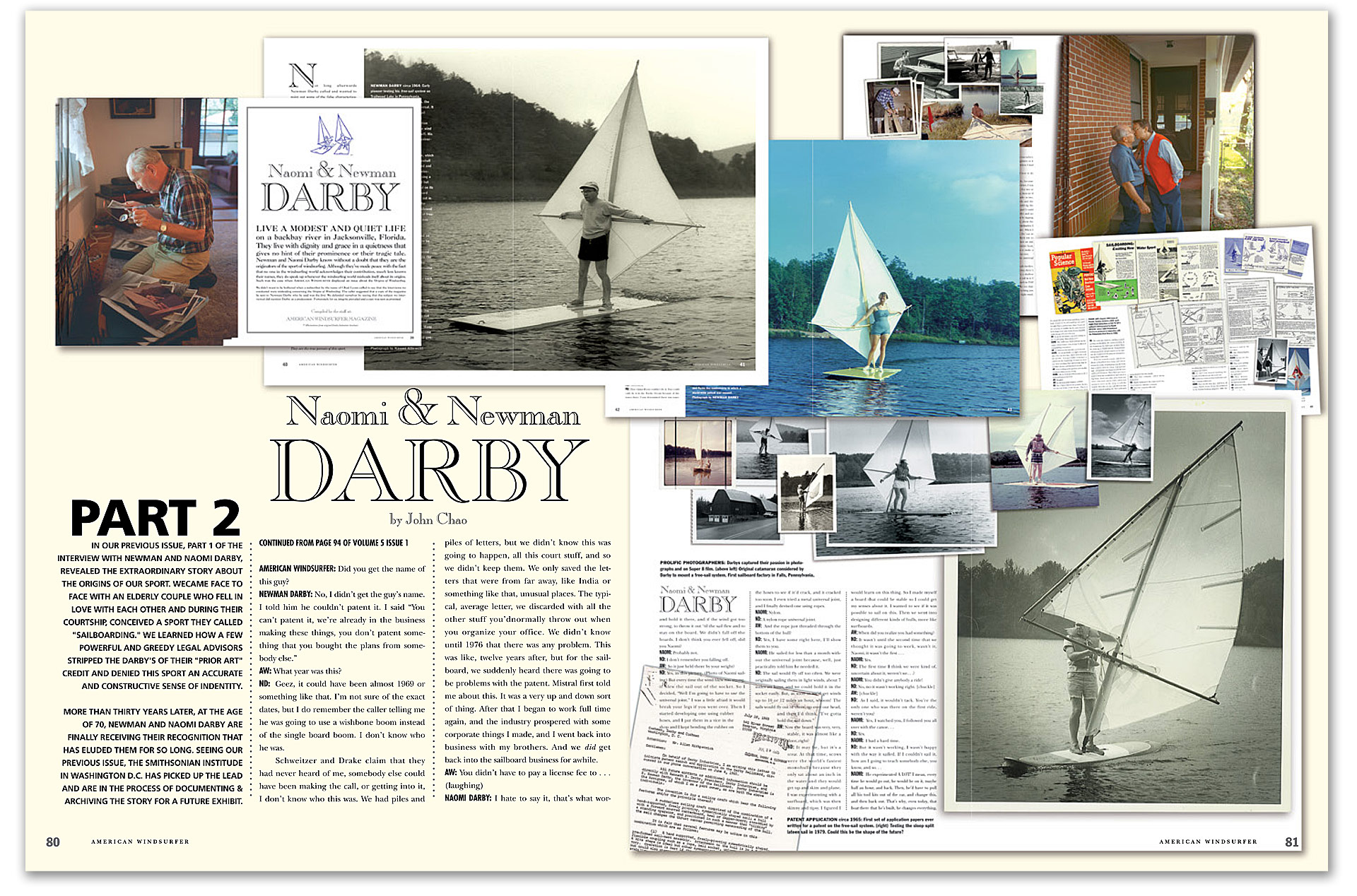Editor’s Note: The original published interview was edited for space limitations. We are posting the full un-edited version here.
IN OUR PREVIOUS ISSUE, Part 1 of the interview, Newman and Naomi Darby revealed the extraordinary story about the origins of our sport. WE came face to face with an elderly couple who fell in love with each other and during their courtship, conceived a sport they called “sailboarding.” We learned how a few powerful and greedy legal advisors stripped the Darby’s of their “prior art” credit and denied this sport and accurate and constructive sense of identity.
More than thirty years later, at the age of 70, Newman and Naomi Darby are finally receiving the recognition that has eluded them for so long. Seeing our previous issue, the Smithsonian Institute in Washington D.C. has picked up the lead and are in the process of documenting and archiving the story for a future exhibit.
CONTINUED FROM PAGE 94 OF VOLUME 5 ISSUE 1
AMERICAN WINDSURFER: Did you get the name of this guy?
NEWMAN DARBY: No, I didn’t get the guy’s name. I told him he couldn’t patent it. I said “You can’t patent it, we’re already in the business making these things, you don’t patent something that you bought the plans from somebody else.”
AW: What year was this?
Advertisement
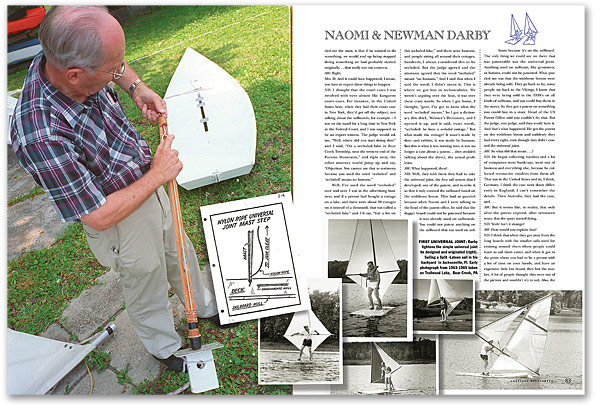
ND: Geez, it could have been almost 1969 or something like that. I’m not sure of the exact dates, but I do remember the caller telling me he was going to use a wishbone boom instead of the single board boom. I don’t know who he was.
Schweitzer and Drake claim that they had never heard of me, somebody else could have been making the call, or getting into it, I don’t know who this was. We had piles and piles of letters, but we didn’t know this was going to happen, all this court stuff, and so we didn’t keep them. We only saved the letters that were from far away, like India or something like that, unusual places. The typical, average letter, we discarded with all the other stuff you’d normally throw out when you organize your office. We didn’t know until 1976 that there was any problem. This was like, twelve years after, but for the sailboard, we suddenly heard there was going to be problems with the patent.
It was a very up and down sort of thing. After that, I began to work full time again, and the industry prospered with some corporate things I made, and I went back into business with my brothers. And we did get back into the sailboard business for awhile.
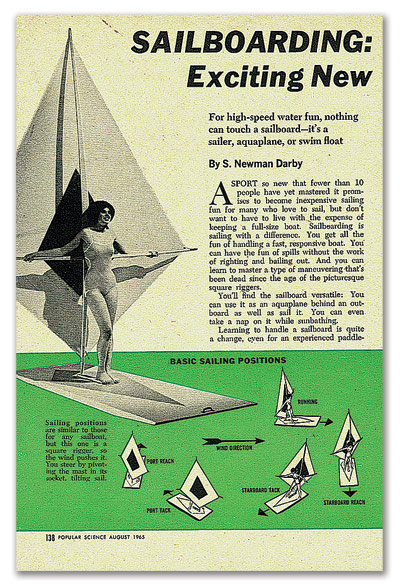
AW: And you didn’t have to pay a license fee did you? (laughing)
NAOMI DARBY: I hate to say it, that’s what worried me the most, is that if he wanted to do something, we would end up being stopped doing something we had probably started originally. . . that really was our concern.
AW: Right.
NAOMI: And it could have happened, I mean, you have to expect these things to happen. I thought that the court cases I was involved with were almost like kangaroo court cases. For instance, in the United States here, when they had their court case in New York, they’d get off the subject, not talking about the sailboards, for example — I was on the stand for a long time in New York in the Federal Court, and I was supposed to be an expert witness. The judge would ask me, “Well, where did you start doing this?” and I said, “On a secluded lake in Bear Creek Township, near the western end of the Pocono Mountains,” and right away, the other attorney would jump up and say, “Objection. You cannot use that as testimony because you used the word ‘secluded’ and ‘secluded’ means no humans.”
Well, I’ve used the word “secluded” over and over. I was in the advertising business, and if a person had bought a cottage on a lake, and there were about 30 cottages on it instead of a thousand, that was called a “secluded lake” and I’d say, “buy a lot on this secluded lake,” and there were humans, and people sitting all around their cottages, hundreds,.I always considered this to be secluded. But the judge agreed and the attorneys agreed that the word “secluded” meant “no humans.” And I said that when I said the word, I didn’t mean it. This is where we got lost in technicalities. We weren’t arguing over the boat, it was over these crazy words. So when I got home, I thought, “geez, I’ve got to know what the word ‘secluded’ means.” So I got a dictionary this thick, Webster’s Dictionary, and I opened it up, and it said, exact words, “secluded: he buys a secluded cottage.” But what made the cottage? It wasn’t made by deer and rabbits, it was made by humans. But this is what it was turning into, it was no longer a case about a patent. . .they avoided talking about the direct, the actual problems.
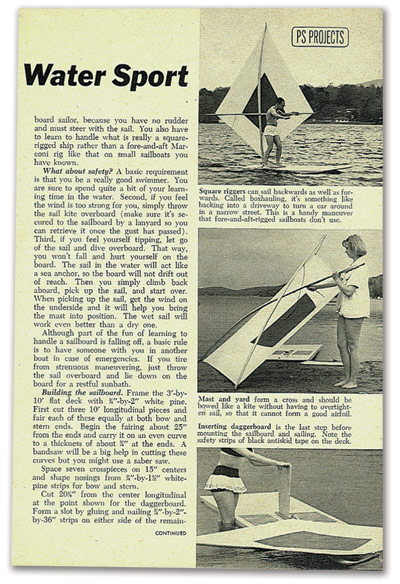
AW: What happened, then?
NAOMI: Well, they told them they had to take the universal joint, the free sail system that I developed, out of the patent, and re-write it so that it only covered the sailboard based on the wishbone boom. This had us puzzled because when Naomi and I were talking to the head of the patent office, he said that the dagger board could not be patented because it was already used on sailboards. You could not patent anything on the sailboard that was used on sailboats because it’s on the sailboard. The only thing we could see on there that was patentable was the universal joint. Anything used on sailboats, like grommets, or battens, could not be patented. What puzzled me was that the wishbone booms were already being sold. They go back so far, some people say back to the Vikings. I know that they were being sold in the 1930’s on all kinds of sailboats, and you could buy them in the stores. So they got a patent on something you could buy in a store. Head of the US Patent Office said you couldn’t do that. But the judge, one judge, said they could have it. And that’s what happened. He got the patent on the wishbone boom and suddenly they had every right, even though they didn’t control the universal joint.
AW: So what did that mean . . .?
NAOMI: He began collecting royalties and a lot of companies went bankrupt, went out of business and everything else, because he collected retroactive royalties from them all. That was in the United States and in, I think, Germany. I think the case went down differently in England, I can’t remember the details. Then Australia, they had the case, and . . .
AW: But it seems like, in reality, that only after the patent expired, after seventeen years, that the sport started dying.
NAOMI: Yeah! Isn’t it strange?
AW: How would you explain that?
NAOMI: I think that when they got away from the long boards with the smaller sails used for cruising around rivers where people could learn to sail them easier, and when it got to the point where you had to be a person with a lot of time on your hands, and have an expensive little fast board, they lost the market. A lot of people thought they were out of the picture and wouldn’t try to sail. Also, the jet boats came in. We didn’t have the competition with the jetboats, and now they’re selling. It’s like a fad, things come and go. I think there’s a need for a sailboard that can be used by senior citizens and older people, one that’s user-friendly. Our first sailboards were far more user-friendly than the boards today.
Advertisement
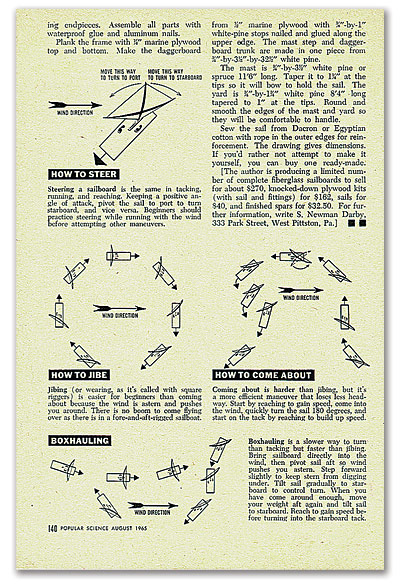
AW: Why did you get discouraged? Why don’t you make one?
NAOMI: I would love to make one if someone would take an interest. I’ve tried over and over, I’ve sent drawing after drawing of user-friendly sailboards to Mistral, and they said they’re great, they work great, but they don’t want to re-tool. Other companies, too, over in this country, they came to my house, I went to their house, stayed with them, I showed them all these sketches and drawings, and we can make user-friendly boards that could be used by everybody, and they all just, they’re afraid to move away from the standard shape. A lot of it is, one-design racing, they all wanted to use the same kind of rig that was used on one-design racing, and they wouldn’t go into using user-friendly boards. I think if they use user-friendly boards . . . most people I teach them out here to sail, they get so discouraged, they don’t try it again, with the regular rig. And if they use user-friendly boards, I think they’d probably have about, instead of 80 percent of the people quitting when they learn, they’d have 80 percent of the people still sailing. I think there’s one of the big things . . . the companies’ instructors will not, nobody uses a user-friendly board for people, and not just the board, but the sail rig’s the most important in that factor, the shape of the sails.
AW: Your balanced kite rig would be the . . .
NAOMI: That one is easier to sail, but that sloop rig, if you wanted to learn to sail the rig they’re using now, the wishbone boom, the sloop rig is more compatible, learning that, than the kite rig, the kite’s a little bit different, but both of them are easier to sail than the . . .
AW: The sloop is the one that has the little jib in the front?
NAOMI: Yeah, because, as I say, when you bring the sail up, mast up straight, you don’t have to keep cutting it forward or getting knocked off backwards, and this seems to be one of the biggest things. In fact, I actually already owned one of those sails before I made this kite sail, and uhh, when I was experimenting with it, it seemed so impossible to handle that I wouldn’t even try it because I didn’t know the human could possibly get himself organized, to sail the off-balance sail. It seems that people can develop to do what things you can’t believe, like jumping off big waves and taking loops and everything else. But that’s almost beyond so many people that I think that . . . if you’ll notice in this book here I’m showing you, I was thinking of all of, other types of reasons for using the free-sail system, like my brother Ken . . . he takes two sailboard sails and puts them on a catamaran, and they can put six or seven people on this big catamaran which is made out of two canoes, and they’ll go way up the Susqua’na River, and they’ll sail down, they’ll take these sails up, and they’ll use that when they have their picnic on it, and they’ll use a free-sail system and sail home steering it with the sails. It just shows there’s other ways of doing this besides just on that little board that sinks. I think that the whole industry could be far broader and use as many different kinds of sails, what, the two men that crossed the Atlantic Ocean here, they come up on the beach over here, and they’re from France, and I met them over here. I sat in the tent with Charles Bennett, he’s a congressman, and we met these two Frenchmen, and they must’ve been thirty or so feet long, this big long sailboard, you’ll see pictures of it . . .
AW: The other one is Fred Beuachene, which is, we’re doing a, he went on and did an indoor, he’s the guy who invented indoor windsurfing.
NAOMI: Oh! You know him, then.
AW: Yeah.
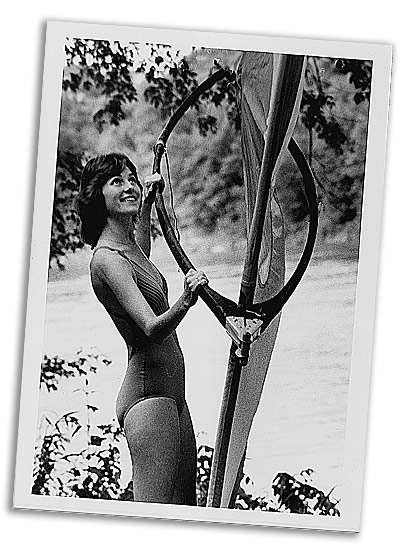
NAOMI: I met them over here at the, I think Timex Watch or somebody was a sponsor, yes, I met them over here, and shook hands and talked to them. But to give you an example of the different types of sailboards that can be used, but they used the same rigging, there’s different rigs on it, the more leading edge you get, the more efficiency . . .
AW: They used the same rigging as you did?
NAOMI: Yes. No, no they used the typical wishbone boom that‘s being used today.
AW: It just seems like this whole thing has been such a travesty and injustice, it just doesn’t seem like there’s anything that can happen that would compensate you guys.
ND: Well, we never got paid much for it.
NAOMI: I don’t think that’s the problem, ‘cause even, as soon as we had it printed in Popular Science we actually figured, once somethings published, it’s free to everybody to use. And that was really our outlook. And really, Newman really, alls he wanted to do was promote it. You know, once we didn’t have a patent, we just felt, “Good! Everybody, the more people involved, the better it is for the sport”, and really, that’s our attitude. He’s got a patent design right now on a boat that’s probably going to be the start of something else. ‘Cause I just bought a kayak and I bought it and I laughed because there was, it’s not exactly his bottom that we have a patent on, and this, we do have a design patent on, but it’s so similar, and we don’t care. . .
AW: Mmmhmmm.
NAOMI: But, you know, it’s just that people, he’ll come up with an idea, and it’s just that you just wish somebody would say, “Yeah, somebody thought of it.”, you know, instead they don’t want to acknowledge anything that Newman’s done, it’s just his nature to keep changing and thinking of the unusual. And I can’t help but think that sometimes he’s — that’s the only part I get mad about, the money doesn’t bother me because that isn’t a problem, as long as you have enough, that’s, that’s the main thing, but not getting anybody to, in fact, when he would write to magazines, like right now, before he knew about your magazine, he had written to another magazine. Now we find that, I believe, Mr. Drake, I’m not sure, but I’m told that he’s one of the writers on there, or these people are affiliated with windsurfing, and so they say, “Yes, that’s a nice article” but it will probably never get printed. And we didn’t realize that this was going on . . . a lot. That they controlled the magazines, and so if you would write an article, they just don’t want to, don’t want to do anything. In fact, the article I wrote for his boat that’s out there now, Mr. Bolger is another one, that if he’s on a magazine, Newman isn’t going to get published in that magazine because he controls the contents of the magazine. You’re probably the first person that comes in, and I, you know, that is going to, hopefully, print what has actually happened.
ND: Well, this is not uncommon, because I understand from a patent attorney, right at this time, now, that there’s amendments going through congress, a very serious thing, small men who invent things who don’t have millions of dollars behind them, big corporations, the dream teams, come in and just take it right off them, and they’re actually trying, in congress, to see what to do to correct this, this has been going on for a hundred years, and right now, for the first time, they’re trying to do amendments and big changes, major changes, in the patent office, to try and stop this from happening. I don’t know if they can do it, but they’re going to try. It’s not just us, this is happening constantly, oh, for example, the radio. You probably think Marconi invented the radio, wireless, you know, have you ever heard of Marconi? Well, a Russian Orthodox Priest in Wilkes Barre, Pennsylvania, they claim, made the first radio, and was demonstrating it to his people, I know, I used to work right near this church, we know people who even, I know people who were there when this happened, made the first radio. And I talked to them. The little man next door, member?
NAOMI: Mmmhmm.
ND: My father remembers those days. There’s a hundred people in the church that saw him, with the wireless, and of the friends came in, his name’s Marconi, and Marconi thought it was great. And he went out and developed it. But they never told about the priest who built the first one. And now, the Smithsonian Institute began to realize this and they have a big plaque in the front of the church. I mean, the guy’s been dead for maybe fifty years, and they’re now giving him credit for this. And also, my daughter took communications in college, and his name was first, and then Marconi, that he developed it. But his name was never first before because, and this is, typical of big important inventions, I could name one after the other, that the same thing has happened, that other persons took it over and modified the version, but they didn’t invent it. And the guys that modify, the money, the multi-millionaires, they try to take credit for the whole thing, and this was the patent office, right now, at this moment, is actually trying, like, everything, to do something about it. I don’t know if they’re going to succeed, they’re trying, though.
AW: So they recognize the problem?
ND: Oh, yeah! It’s a major, and there’s a major people in the patent office and in the US, amendments in the congress, and everything else, it’s going on right now, I’m told.
AW: So Naomi, how do you guys comfort yourselves?
NAOMI: I don’t think about it. (laughs)
ND: That’s it.
NAOMI: I just don’t think about it I just go and do everything.
ND: Yeah, we just do . . . I keep making boats. My hobby and pleasure and fun with designing, developing new boats, and uh, if I think about all these other characters, what they all do when they see my boats, I don’t know what I’d ever do because it’d drive you crazy. They keep calling you up, and calling you up, and changing things. We’ll show you some of the new boats later on, out here.
NAOMI: Yeah, there’s just, you just don’t even think about it, because ahh . . .
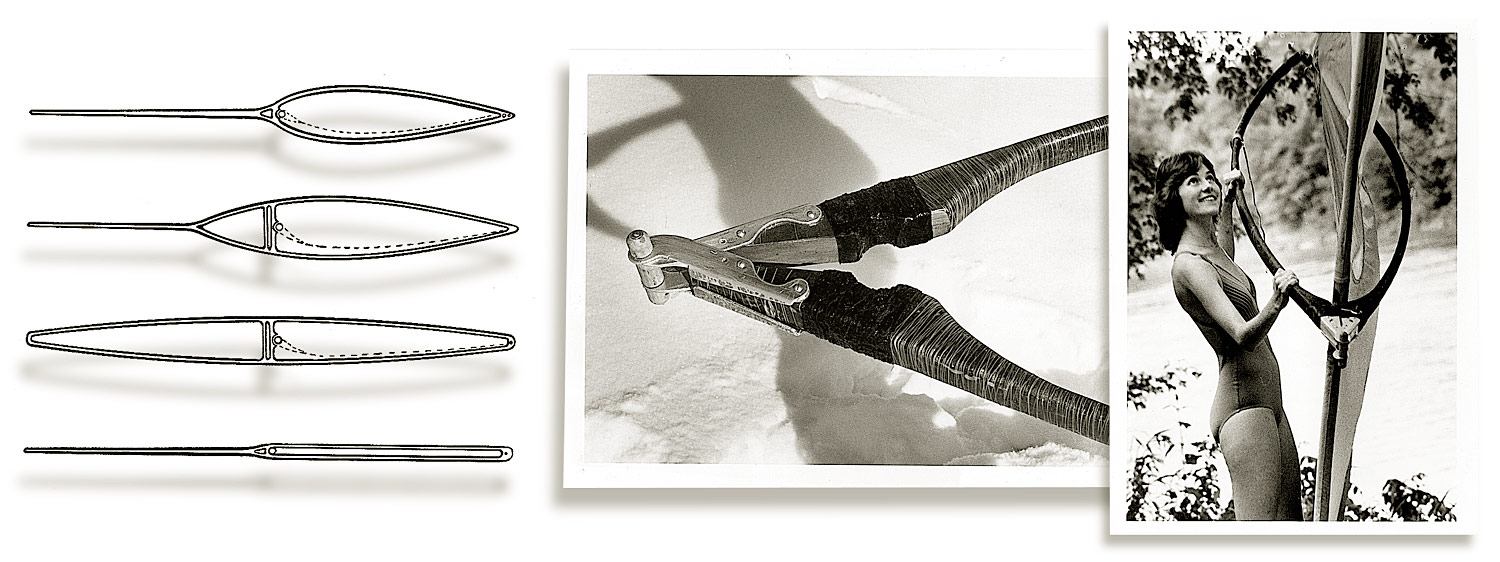
ND: It’s probably the only dinghy in the world, right in front of you, that has no dagger board on it. And it only draws that much water, and it can tack upwind, and it’s fast. . .
AW: There’s no dagger . . .
ND: No, that’s an invention, a new development, and there’s no, you can start it right up, over sandbars, or big beaches, right there in front of you, not only that, but it’s extremely fast, in fact, it’s so fast it scares Naomi sometimes.
AW: And you have a patent on that.
NAOMI: On the design, yes.
ND: Design patent.
AW: You learned from your experience, huh? (laughs)
NAOMI: A patent’s only as good as your first battle in court, and we probably don’t have any money to battle in court. It just really, so people, he would get some recognition for what he’s done, that’s the bottom line.
ND: They made a modification on it, and had a dream team of attorneys, the court case starts, for infringement, about a hundred and fifty thousand dollars. We don’t have a fraction of this kind of money, that’s put out for attorney fees. So we don’t even try . . . and then you’re going to have a big corporation worth maybe a billion dollars, with about four or five attorneys, and all their public relations people and all their advertising people pouring it all on over you to stop you. And here we are, two ordinary people, and this is, when you come up with an idea, what happens to you. And this is not only me, this is all the inventors in the country, that’s why the patent office is so disturbed. These dream teams can come down and just crush a little man, take it right off him.
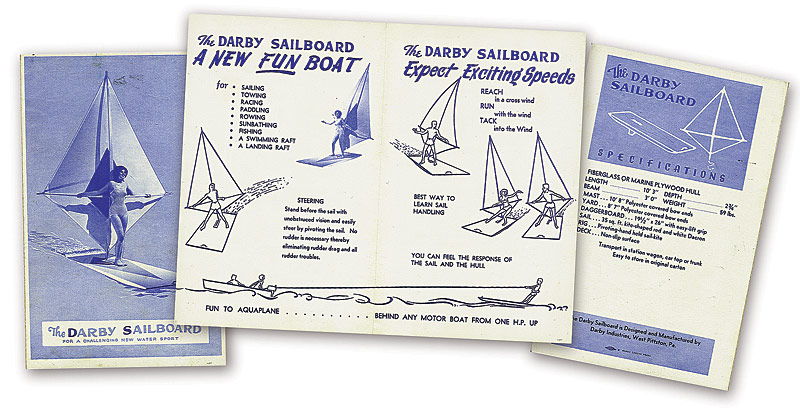
AW: Mmmhmmm.
ND: It’s happening all the time, I’m not going to worry about it, because it happens all the time.
NAOMI: If it wasn’t for the other greedy people on the other side, they probably wouldn’t even know Newman existed because the only reason they brought him to the surface was to fight the patent with the idea that might get it, otherwise, possibly, they never would have heard of Newman if that didn’t happen. I mean, that’s the truth of the matter. So, because the’re other people on the other side that wanted to fight it knew there was a possibility, that’s the only reason they brought him to the surface. Otherwise, he might not have had any recognition, let’s put it that way. I mean you can, that balances one off.
ND: Well, when I designed the, a catamaran that you can use on the beach, I do not know yet if that was the first beach catamaran that could tack off the beach or not, but I sold the plans to Popular Science magazine, and again, six million readers see it, and within a month or two, there was a catamaran factory, it was the biggest in the world at the time, they’re called AquaCat, and they had dagger boards on them. They’re being manufactured up in the Carolinas here, and the president of the company came right to my shop because they saw this in the magazine. He wanted to know how the heck were you sailing off the beach without a dagger board and back on, and we talked about boats, and I took him out and showed it to him, he showed me his boat, we went on for hours. Years later, they did build a beach catamaran. But I never had . . . I started the patent, and then I ran out of money with attorney fees (laughs). But I did start a patent on the catamaran, but it wasn’t on the beach part, no, dagger board part. I patented the method of folding it and putting it, storing it in cars and things. But anyhow, I did a six page article, and I can show you the article, in Popular Science. It’s only because of that article that they came in to see our sailboard because they called Naomi, and told her, they were told by experts that it’s impossible to stand on a surfboard and hold a sail. And these are the top world designers, developing sailboats, you cannot hold a sail standing on a thing like that. Even years after we were doing it, they kept telling us you couldn’t do it. That’s why, in this sport, this is the simplest form of sailing, as you probably know, and the materials they had, they could have built them in the Roman days, and like, for instance, if the Romans were going to invade with their old square riggers, were going to invade a place, or back in the days of Columbus, those old square riggers, these things would’ve sailed circles around them, and especially in days they had bows and arrows, their top speed was ten miles an hour, and they couldn’t go against the wind, they only went in one direction. Well, you can imagine about a thousand in the wings on these things with bows and arrows, going around them, they couldn’t even shoot back at them because they had bows and arrows too. They could fire them, go upwind, and fire at them, and always further. They could’ve stopped invasions with a bunch of sailboards. And they had the materials to build high-speed sailboards for the ocean. But nobody thought it was possible. The board changed the history of whole nations being conquered or not conquered, just by having these simple little sailboards that they could have . . . when they saw incoming invaders, they could have . . . they’re so fast they could go out in the ocean and they would have, like a reconnaissance, and spot them, there’s a whole fleet coming in. They never knew this, they had no radios, they had no airplanes, nothing. But the sailboards were three times faster than those old ships. And also, sailboards can tack against the wind, and the old ships only went one way. That’s why there’s thousands of them sunk up and down the Florida coast here because they, when the wind blew the wrong way, they all smashed and sunk!
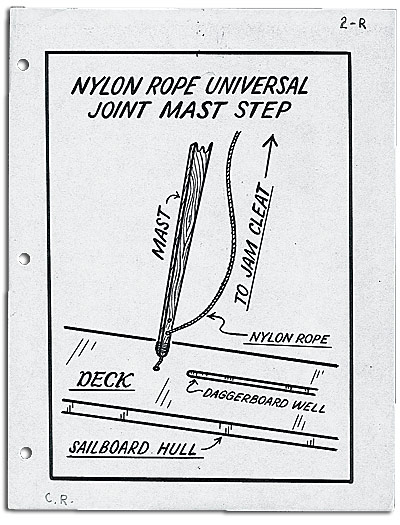
AW: Well, at least you have the satisfaction of knowing you were first.
ND: That’s some . . .
NAOMI: That’s really what, you know, to me, the bottom line is that he gets credit for doing it. Up until all, this thing started to surface, he wouldn’t have gotten any credit at all.
ND: I need to thank Jim Drake and Schweitzer for bringing the publicity to it, we did it! (both laughing)
AW: Jim is saying the same thing about Hoyle.
ND: Oh, yeah?
(all laughing)
AW: Yeah.
ND: Well, they came along quite awhile after, when the whole industry was going.
AW: What do you say to people who say, “Yeah, you may be the inventor, but really, Hoyle Schweitzer is the guy who really popularized it”?
ND: Same thing for the Ford car. You know, I met an attorney, who fought the car, gasoline and water combined with four wheels, he’s a windsurfer. And he and one other guy, patent attorneys, that fought with Ford, there was a Ford factory in Jacksonville, manufactured Ford cars. Years and years after the patent ran out, the people who had the patent on the car kept collecting royalties, and Ford said that’s illegal. And this man I met one day on a windsurfer, eighty years old, I was sitting there, and he was one of the attorneys that worked for Ford to try and break the patent so that Ford didn’t have to pay them because seventeen years passed, and they kept billing all the car companies anyhow, and they kept on sending them the money, and Ford just said, hey why am I sending all this money, thousands and thousands of dollars to these people when it’s about twenty years, way past the time. So this was this man sitting on a windsurfer was telling me that he was one of the attorneys that helped break the thing when the patent, when Ford was manufacturing cars out of Jacksonville. Funny, here it is I’m sitting and talking to an attorney from the . . . but it was the same thing. You’re talking about when the patent runs out and the whole thing gets free, they aren’t supposed to pay it, but all kind of strange things happen. Attorneys kept on working on it and working on it and working on it.
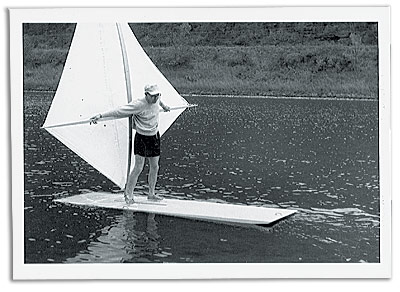
AW: But what do you say to people who say that Hoyle Schweitzer popularized it?
ND: He, he did, uhh, let’s see now. We had publicity out, we figured, uhh, that’s, that’s . . . we were the first to public—, for years and years, our publicity was far stronger than Schweitzer’s because, as you know, there are six million readers to Popular Science, six million to Popular Mechanics, how many people watch “The Price Is Right”, it’s international television, maybe Ten million or Twenty million. Then we had it in boat shows, then I published it in magazines in Europe, and this is all before Schweitzer is involved, no promotions at all. He didn’t come along for four or five years after, all his promotions. So we were promoting it, and their are millions of people knowing about it. I talked to a lot of sailors who’d seen our articles, who are windsurfers now, including like, Ken Winner. He said he saw my article in the magazines. Well, in Mistral, how they found me to come to our house, they came to us. One of the men working in the plant had my plans, and that’s over in Germany. So we were known by a lot of people.
AW: But still, the windsurfer who would be credited, yeah, your stuff started dying off, and they picked up the baton and ran with it.
ND: They did, and it’s kinda the same thing I said Henry Ford did with the car, there were all these cars being hand-made and they were costing so much money people couldn’t buy it. He put it in mass production, he ran with it. But, meanwhile, there were a thousand car manufacturers before Henry Ford. But a lot of people think Henry Ford invented it, but no — promoting it, is uhh. I don’t think that Schweitzer probably didn’t make as much money as you might think from manufacturing them. I think he made more on the royalties and the patents.
NAOMI: Mmmhmm.
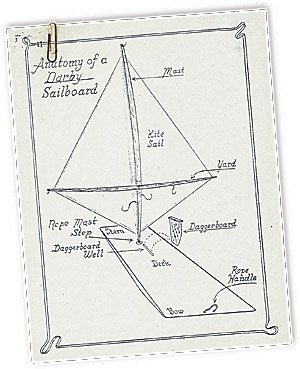
AW: That’s right.
ND: It wasn’t from manufacturing and selling sailboards.
NAOMI: Ken Kater, I think, was what really launched him. And that sport was just ripe for the people there.
ND: Europeans. They still like it, the Europeans still . . .
(dog barking)
AW: So tell me what do you see in the future, here?
ND: The windsurfing? uhh . . .
AW: Mmmhmm.
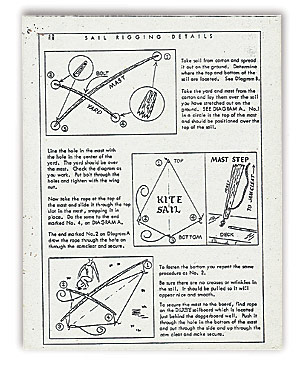
ND: Well. It could, it could be like a phase. Right now, jetskiis are coming in so strong. Before it was water skiing, now the jet skiis are coming in so strong that it might fluctuate back and forth. In fact, right now, I happen to be involved with water management and keeping clean streams, and Naomi helps out with me. Fact, just before she went to the hospital, she’s over there cleaning the river up, we had a campaign where you clean the river, you know? I was, for awhile, taking chemical analysis of the water for state water management, and this is happening all over the United States. They’re trying, a lot of states are seriously considering outlawing the two-cycle engine because of tremendous pollution. This will mean that, if they outlaw them, it’s going to change this all around, however I haven’t heard it in Florida yet. But I talked to people in Washington, they said that congress was putting things through. They could make them four-cycle, (Thom?) (353 counter) is the only one making a four-cycle outboard motor, that’s a big company right now. All the rest are two-cycle, even the outboards and the jet boats. Now, they’re the ones that are coming in full force now, each jet boat, each motor boat makes pollution of over one hundred cars.
AW: Really?
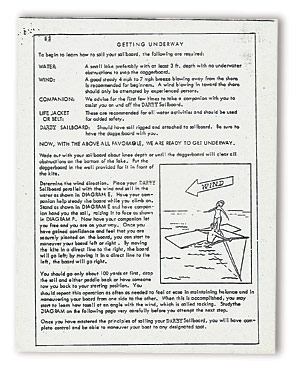
ND: That’s why they’re concerned about them. Also, when they leave wakes, they kill thousands of fish, when they go up these small streams, and all the eggs and small fish are back in the bushes and trees. They put breaker-size waves, like ocean waves, into these back waters, up in through here. They killed thousands, maybe millions of fish in a weekend. And so because of this, the environmentalists are considering, and it’s going through various states, I forget how many, there must be ten states now, and I don’t know how far it’s going to move. This river here, right now, there’s things in the paper, the water being polluted too much. And what to do about them. So ah, that would change the whole factor there. This is a clean sport. If that’s what has to stop, if they’re going to have to switch, four-cycle motors are going to cost probably twice as much, and it’s going to be heavier and slower, and it might change the sport there. Water skiing, when I started making the first sailboards, it was water skiing was one thing that I noticed that everybody’s going into. But only a few people had enough money to buy a big motorboat, and it would take about three or four people sitting in the boat and one guy in the back. It was quite dangerous, believe it or not, and it pollutes, like over a hundred cars. I used to belong to snow skiing clubs and in the summer time we used to water ski with motorboats on lakes. In the club, if you had fifty or a hundred people, you were lucky if you had three people in a motorboat. So they all sat there, not getting turns. (phone rings)
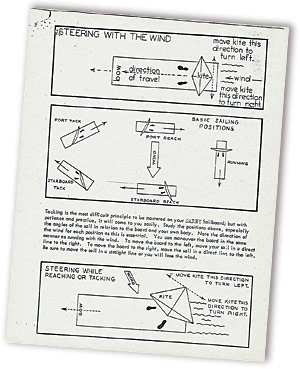
ND: I don’t understand, about the first sailboard, I mean not because it’s cheaper . . .
AW: Oh, we were talking about the future, right?
ND: Oh, yeah, okay. That’s right.
NAOMI: Myself, I think it will emerge as a different animal.
AW: Tell me more about that.
NAOMI: Well, I think they’ve gone, and a lot of it, they just keep jumping off the waves. Now, somebody like me, there’s no way I’m going to do it. I went up to Lake Wampompak and I got it hydroplaned, and go fast, but I think there’s a lot more people that just want to go out and cruise around. And these are forgotten. And I think there’s a whole lot of people, elderly, ‘cause you have the babyboomers right now, and they’re active. They would probably like and enjoy this. Also, they’re thinking about the environment, so they want it clean. There’s a clean sport, but the thing is, you need clean water to do it. You don’t want to fall in polluted water.
AW: Right, right.
NAOMI: So there’s a kinda deterrent, but as people are thinking more this way, I think you’re going to find, possibly when they come up with, and that’s what I said, I think Newman’s sail eventually, it’s going to come back, but it takes a long time for these things to develop, for people to accept new ideas, for powers of change, and ideas you have to change. And you don’t change ideas overnight. It just takes a long time. So maybe we will live long enough to see it, maybe we won’t . (laughs) It’s one of those things. Possibly you’re going to see different types of boats that you would sail that way, and I think they’re going to have to appeal to different groups of people. People that maybe don’t want to jump off the wave, and don’t want to be . . . a water sport, you know, that type of thing, but just want to go out for an afternoon cruise, and come back, and just enjoy being out on the water.
AW: What was it like when you first went out on this thing, when you think back to those days?
NAOMI: It was really exciting. I always enjoyed it ‘cause your standing up. I think you have more control with your sailboard, I mean that surprised me over a sailboat because you can just stop and turn right around within the diameter of your boat, where you can’t with a sailboat. I’ve sailed regular boats, and you can get yourself in some ticklish situations where I think with a sailboard, you just have more control. People don’t realize that. Not a beginner, of course, but once you know what you’re doing, I think you have a lot more control, and it’s just a nice way to go out and view the water. I think you feel better.
AW: How do you feel about being recognized as the first woman to ever windsurf?
NAOMI: I don’t think people know that, and I haven’t really promoted that idea (laughs), believe me, I haven’t.
AW: Have you ever thought about that?
NAOMI: Nnno. I always think of Newman as being the first, ‘cause he was the first on it.
ND: She made the first sail. She tried to talk me into making them, I think, as our conversations, this is why we might not have gotten our, actually, got enough ambition, you know, it’s a lot of work to make a sailboard and not even have any idea if you know it’s going to work. And if you get done, you’ve wasted your time, this thing is no good, and throw it away, then you’re going to put hundreds and hundreds of hours making a thing, and she kind of got me enthused. The two of us together, our minds going together, got building it. I knew how to design it, but whether or not to really put the effort in . . . when you’re making an invention, you’re not sure if it’s going to work. It’s one thing to get a kit and build something, you know it’s been done, and think it’s going to work, but you start making something that you’re not sure, and putting all those hours in, and then, you figure it doesn’t work, what are you going to do? Burn it, throw it away? It’s quite a gamble.
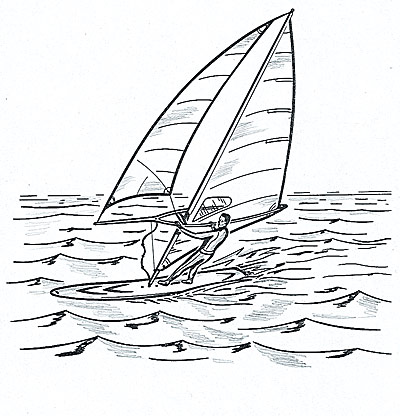
AW: Well, I’m very honored to be in your presence.
NAOMI: I wouldn’t say that! (laughs)
AW: It’s truly remarkable. And this is going to be a very good story. I’m very happy with it.
ND: I hope we’re helping you out.
AW: Yeah.
ND: Get some new ideas.
AW: Yeah.
ND: Now, I wanted to show you this thing. The reason they, the publicity has been very bad about the fact that we started a scow because they act.
AW: Actually, no. I want to take some pictures. Maybe we can finish this up real quickly. Show me quickly, then we’ll go.
ND: These are scows, and here’s a different one . . . A scows, B scows, C scows, these are the world’s fastest mono-hulls . . .
AW: Right, right, right.
ND: And, design after that. Now people tell me that the scow is inefficient. How come, basic, this is half-size of one of these scows, and they’re not inefficient, they’re the world’s fastest. Yet people keep saying, because it’s a scow-shape, it’s like a boxy thing.
AW: Could it be too heavy?
ND: No, no. They can be real light. That’s not the problem. They’re tremendously fast. Even after it was fast, the world speed record at the time we took this out was eleven-and-a-half miles an hour for sailboats under twelve feet. That motorboat that you saw that Diane was running along the side and the photographers were taking her pictures, could do fifteen and eighteen miles an hour. He knew that we’re in, speeds beyond what any of that size went, see.
AW: So you wouldn’t hesitate at all to go back to the scow shape? Even today, after all. . .
ND: Out here, in this flat water. The flat water’s also fine. But out there in the rough water, hit the waves, the waves slow a scow right down. These are used where there’s a lot of flat water, and these are big scows, they’re world-famous. See, people who don’t know about boats don’t realize that the scows were, and they’re still used on the Great Lakes. There are some big racing classes up there, this type of a boat. And that was designed after the scow, which is efficient, and they claimed that that’s not efficient, they don’t seem to . . . because it looks squarish and boxy, the don’t realize that it was that efficient. And also stable, it’s very stable, that’s why you did it. But I don’t know about going back to the scow because people today want to be in waves.
AW: It’s like what Naomi said, it’s going to have to re-invent itself.
NAOMI: Right. I would say that there should be a lot of different kinds. I think that, if you knew you would have flat water, you were going to sail there, you would want the best hull shape to do what you’re going to do the most. I mean me, if I see a wind blowing, and I’ve done this, I’ve gone out to sail with Newman, and I’d say, “No, I’m not going to sail today ‘cause there’s just too much wind for me”, I know that I only like to sail in certain winds. And I know I have a reputation for that. But if it’s too low, no, I’m not going to go sailing. If it’s too high, I don’t go sailing. But when it’s just right, then I sail. And I think probably there’s more people like me then there are the other kind that want go out and just, you know, tear around. He belongs to Jaws, which I don’t go with him either for the same reason, I don’t like to talk a lot about sailboards.
AW: Because it’s so painful, or . . . ?
NAOMI: No, I just, I just. It irritates me, let’s put it that way. I just get irritated and it brings back memories that I would rather not have.
AW: Yeah, yeah.
NAOMI: So, it’s just better for me to go forward and so. . .but he enjoys it.
AW: Does it bring out memories that are failure-type memories or . . . ?
NAOMI: Ahh, frustration. Mainly because I, to me, if something is a fact, it should be known. And to say something is not what it is, without anybody testing it, trying it, or proving it, to me, it just isn’t right. I believe if something is, it is. And people saying that it isn’t, without knowing, or checking — this to me is wrong. It’s actually caused me to not believe what I read. And I’m not the only one ‘cause I sat with Mr. Hershak, I had the pleasure of sitting with him through a court trial.
AW: Who’s he? Is this the lawyer?
NAOMI: Mr. Hershak, who’s the boat architect.
ND: His father was one of the most famous designers in the world for Mekka Cups? (402)They also sell wishbone booms for sailboats.
NAOMI: And then he told me the same thing. He said he would open up a book and find people writing about him, that he had no knowledge of, and half of it wouldn’t be true, and so I guess that’s just part of, if people know your name, and they just decide to write what they want to, which I find is wrong.
AW: What did you think when you saw our issue with the two interviews with Jim Drake and . . .
NAOMI: I’ll be honest, I didn’t read them for the same reason. I didn’t want to go back over it. So, Newman, I’m sure read it, and he found a lot of inaccuracies, and we thank you for that because otherwise, these things will be picked up by other magazines, unfortunately, and printed, and it gets to be more fact the more it’s reprinted. And that’s basically what has happened.
ND: That’s what’s happened. They keep reprinting the same old stories over and over again . . .
NAOMI: And never check, and of course, we don’t have time, we’re too busy making a living and going on with our life, to fight every little incorrect thing. You’d spend your whole life, and that would be a sad life. I mean it’s better to just say, door closed, let’s go on.
(Second tape)
AW: We were talking about uhm . . .
ND: Well, this is, certainly, this information here is sent to me by the attorneys from Mistral sometimes from Sail rider, and it’s about the history of the wishbone boom. These attorneys . . .
AW: Alright, let’s go back for a minute. The wishbone boom is the only thing that qualifies or was able to patent.
ND: The combination of the sailboard and the wishbone boom, that’s what was patented. That’s what I ended up, ‘cause they had to re-write the patent after the court case in New York City, where I was there, my brother Ken and myself were called in as expert witnesses on the subject. I thought the court case was almost a kangaroo court case myself because they seemed to get off the subject and be concerned about terminology, as I told you before, more than they were the product itself, and they didn’t, they’d eliminate material that should not have been eliminated, just out of trickery, as it turns out, they were pulling tricks on us, and I wasn’t ready for these sharp attorneys, I didn’t have an attorney of my own. There were some attorneys from different companies that said they were going to help me out, but I don’t think they did help much, because I was kind of left up there alone, and my brother, neither of us had attorneys with us. So when we’d say something, we didn’t have anybody to back us up, and help us sometimes. When they got done with the court case, we had the universal joint on our first sailboards and therefore, they couldn’t have the patent for that exclusive of the universal joint.
AW: Now why couldn’t you go ahead and get a patent for the universal joint?
ND: According to law, and the US Patent Office, one year after you’ve published an article on your invention, it’s against the law to patent it. We had it in Popular Science magazine in 1965, so in 1966 it was now open to the public for anybody to build it. We weren’t making any money, we didn’t really care because we didn’t think there was any money in it. We just did it for fun, deliberately began to encourage people and clubs and everybody to do it and build them because they couldn’t be patented anyhow. So we gave them all the information we could, and we were kind of surprised that, here, years later, suddenly someone through a patent on it.
AW: And the only patent you could get at that time was the wishbone?
ND: They actually put the patent on the wishbone boom and the universal joint. Schweitzer and Drake claimed they didn’t know about the universal joint. Therefore, the companies all came in and had a court case, and then they made them take the universal joint and stand up steering thing off of it.
AW: The only thing they had was the wishbone, but the wishbone clearly was available even back in . . .
ND: Here’s a copy of a magazine article, 1940, they were selling and the patent, the Commissioner of the US Patent Office told me that we could not patent a dagger board because it was on a sailboat before, we could not patent grommets, nor patents on the sails, because the Chinese had them for 5,000 years. You couldn’t patent the batten on the sails . . . the wishbone boom, goes back, I think, to the Viking days, although I’ve no proof of this, I’ve been told this. But here is a magazine article about wishbone booms in the 1940’s, they’re entitled. . .
AW: The new wishbone rig and sail parts
ND: Yeah. This was sent to me by some attorneys who found this material. Many people said that they used. So my wife and I decided to find out more about the wishbone boom. Many people were found to have manufactured the wishbone boom in the 1930’s were the Hershock’s. He’s a world-famous boat designer, just made the America Cups and all this. There’s a museum in Bristol, Rhode Island, there’s the Hershock Museum. About ten years ago, there was an old woman there, about ninety-some years old, it was Hershock’s wife, who was still alive. I didn’t believe it, but my wife read about this. And she was telling me that he did (or didn’t?) manufacture, she was a museum hostess. There was a man standing behind her, and I said, Did Hershock invent the wishbone boom? She said, well maybe he did, but she wasn’t sure, and the old man behind her was shaking his head “no”, so I got to the side and talked to him and he said that there was a sailboat in that area of New England called The Vanwinds, or something like that, he said that they were using them and that Hershocks thought it was a good idea, there were no patents on them. Some people claim they saw in the Vikings, so he thought it was a good idea. But the Vanwinds . . .
AW: So how did Hoyle Schweitzer get the patent?
ND: The judge told him he could have it. I thought that was kind of strange.
AW: Nobody went back and said that history proved that it was available?
ND: I don’t know what they did. They took me out of the courtroom, I was only there half of the time. Sometimes I’d be in the courtroom, then for reasons, well, they wanted to try to make it look like my brother Ken and I were telling lies. So they pulled tricks on me. They asked me how I learned how to build all these boats, and all this stuff. I used to hang out in boat building shops, and I watch them build them, and they’d tell me how to build them. When I built my first boat, a boat builder sat in my shop and watched me and told me. Now my brother Ken was only a child, and wasn’t watching, wasn’t paying attention. He wasn’t even there. So then they took me out of the room, put my brother on the stand, and they asked him, “Did your brother learn how to build boats by reading books?”, and Ken said, “I guess so.” Because I was always reading a book, but actually I was doing homework, but he didn’t know what I was reading, and didn’t care, he was a child. So then they’d say, “Now, see, Darby’s lying because his brother said . . .”, but he didn’t mention the fact that he was only a child, maybe eight years old, and they’re bringing him back here when he’s forty years old, here asking him these questions. All these tricks to try to make us look bad. He kept it up to the point where it kind of provoked me, that’s why it made me so mad. They took me out of the room and tried to make me look like a liar. Then I told Ken later on, I said, Geez, do you remember Jim Kuminski, and he said, Yeah. Well, he’s a boat builder, and he said, Yeah, I know. And I said, “Well, he taught me a lot.” “Oh, I forgot about him.” So they took him by surprise. I might have read a book once in awhile, but I used to sit in the boat building shops and watch them build the boats.
AW: How Schweitzer . . . here’s proof that the wishbone was available.
ND: I thought he was going to lose it.
AW: And Mistral’s people didn’t show this proof, that the wishbone was available?
ND: They should have, as I told you, Mistral’s people were not in court in New York, they were in Munich. They put us in a hotel room with a guard sitting outside our door, they wouldn’t let us in the courtroom, and so we don’t know what happened in the courtroom.
AW: Somehow you managed to get. . .
ND: The same thing happened in Munich that happened in New York. But then, in Canada, he lost the wishbone boom here also. I was in the stand there.
AW: With that wishbone boom, that’s the only thing . . .
ND: That’s what he used for all this suing, and that’s where he got his royalties from. If he didn’t have that he wouldn’t have had anything because. . . there was so much proof we had with the universal joint, and the standing up and steering by tipping the sail, which really was on the whole thing, anyhow, we had so much proof, you had to do something else. The attorneys worked this out, I don’t think he worked it out. I think his attorneys worked it out for him. They were clever attorneys. I realized he worked with Ken Kater, he’s worked for multi-million dollar corporations, like DuPont, big, and they can have attorneys and big backing. It’s like the Simpson case, the attorneys are very tricky. Now I’m showing you these magazines here with the wishbone booms from the 1940’s.
AW: You have a lot of these home movies that were shot during the early days.
ND: In the early days, they were on 8mm movie film. The old-fashioned 8’s, even before the super 8’s came. Naomi owned a movie camera that had a zoom lens on it. We know exactly when the movies were taken because she was expecting a baby, and that was a few weeks later you had the baby, wasn’t it?
NAOMI: Yeah.
ND: So we know what my daughter’s Cindy age is, and when they were taken. What’s Cindy now, about thirty-two years old?
NAOMI: She was born in ‘65.
ND: She took those movies on kodachrome film, and they’re 8mm. They came out very well. On that particular day, we had a high wind, we were lucky. The first time she took movies, they were taken on the Chesapeake Bay, in a little town outside Annapolis, Maryland, called Bay Ridge. My brother had a waterfront home, and he was a partner in the company making them, and we both took rides around on it. Chesapeake Bay is really quite rough for a scow, but we somehow managed. In fact, a few weeks later, my brother Ken went down to Chesapeake Bay and took a sailboard, and we thought Thompson had the record. Chesapeake Bay is very wide, and he sailed all the way across and back, it must’ve been fifteen or seventeen, miles, in the rough water. We didn’t expect the scows to do this, but he actually made his way back on it, without having to paddle or anything. Before that, she took the movies on the same spot, and the wind wasn’t blowing very strong. We had to wear wetsuits because it was during the spring, and it was cool down there yet. We couldn’t sail in the north because it was too cold. Then we waited until the weather got warm, and we had a windy day one day, and we went up to a lake where her father had permission to use the lake. Her family still lives all around this beautiful secluded lake.
AW: Well you have beautiful shots on film. What did you ever do with these?
ND: We have them yet. They’re copyrighted. Doesn’t the patent office have a set of them? Patent office, and who else has them?
NAOMI: They’re copyrighted.
AW: During the court cases, you showed them this film?
ND: Yes, and one attorney tried to say that they were too professional-looking, that it was obvious they’d just been taken recently because nobody could sail like that, and they looked like professional movies. It happened to be that Naomi had just taken a course in movie photography . . .
AW: Couldn’t they see that that was you?
ND: Yes, but they thought that I was just sailing it then.
AW: Couldn’t they see that this was you, thirty years ago? (laughing)
ND: Yes, the judge mentioned to the effect that I had more hair then. (loud laughter)
NAOMI: Schweitzer’s people were trying to say no, that we were lying, that we just took the thing. Naomi was expecting a baby, she couldn’t do much but take pictures. That’s how we knew the exact date. She knew very well the exact date. When Diane outran the motorboat, and got Popular Science magazines photographer so excited about doing an article for it, because of the speed they went. She knows the exact date that happened. Why was it . . .something about a wedding she had to get to. I didn’t know the exact day, but she knows the exact day. She had to be someplace for a wedding. So we had witnesses that knew the exact date of some of these.
AW: You also gave a lecture somewhere and you showed. . .
ND: Yeah, I lectured in Germany. It was the first time, they claimed, that all the manufacturers of windsurfers and sailboards ever were in one place together. A lot of them didn’t like each other, and they were all in one big room, and it was very noisy. They were all talking very loudly, and the acoustics were terrible. Then I brought in the 8mm movie, and they brought in a very strong projector and a big screen, and they showed it, and I was supposed explain and describe what was going on. They were showing this to all the manufacturers. I think they gave a copy to the Mistral attorneys. Several other places have copies of this movie, mostly they were used for court cases, was the main principle, because they said we couldn’t do that, and that we didn’t do it. It proved that we did do it. That movie was probably the first movie of anyone sailing a sailboat without a rudder, and a hand-held sail, and a universal joint, we did have a universal joint on that particular movie. A year before we didn’t have them for awhile. But then we finally couldn’t handle it, and put the joints on them. We were going to use a metal universal joint when we first started manufacturing them. I never made another universal joint for it. One of the men who worked in our plant heard us talking about it, and he made one up out of a hinge, and handed to my brother, who gave it to me. When Popular Science magazine came in, we were thinking we had a patent on the nylon rope universal joint, and thought we could not patent the metal ones, because we didn’t understand patent law. We thought because the universal joint was similar to the one used in a car, we couldn’t get a patent on it, which was wrong thinking. We didn’t understand laws, and patent-attorney stuff. When the photographer from Popular Science got there, I stuck this metal universal joint, it was the only one we had, all the rest of them were nylon rope, we didn’t want to show him that until we knew where we were at. It wouldn’t have mattered, because we didn’t know there was a law that, one year after publication, you can still patent it. We thought the minute it came out in the article, we would have lost the whole thing. Therefore, we didn’t show him the nylon rope universal joint which we wanted to manufacture. In other words, we did not understand patent law. I don’t know to this day if there are disclosures allowed. Today, I usually work with disclosures, that is, if you have a new invention, for ten dollars you take your drawing and invention, put it in an envelope, send it to the US Patent office, and they keep it for two years while you’re talking to people about getting financing, and that proves that you had it at that point. I learned all these things during all these cases, I talked to dozens and dozens of patent attorneys, and as I heard them talk, I learned. I was in these courtrooms and I learned all these things. If we’d had that, I could have put a disclosure on it. But we didn’t know about that, and maybe they didn’t even have them then, I don’t know. A few months ago, I asked officials at the US Patent Office when the disclosure laws, for ten dollars, started, and they couldn’t find anybody in the whole room, who knew. They were all young people, they didn’t know.
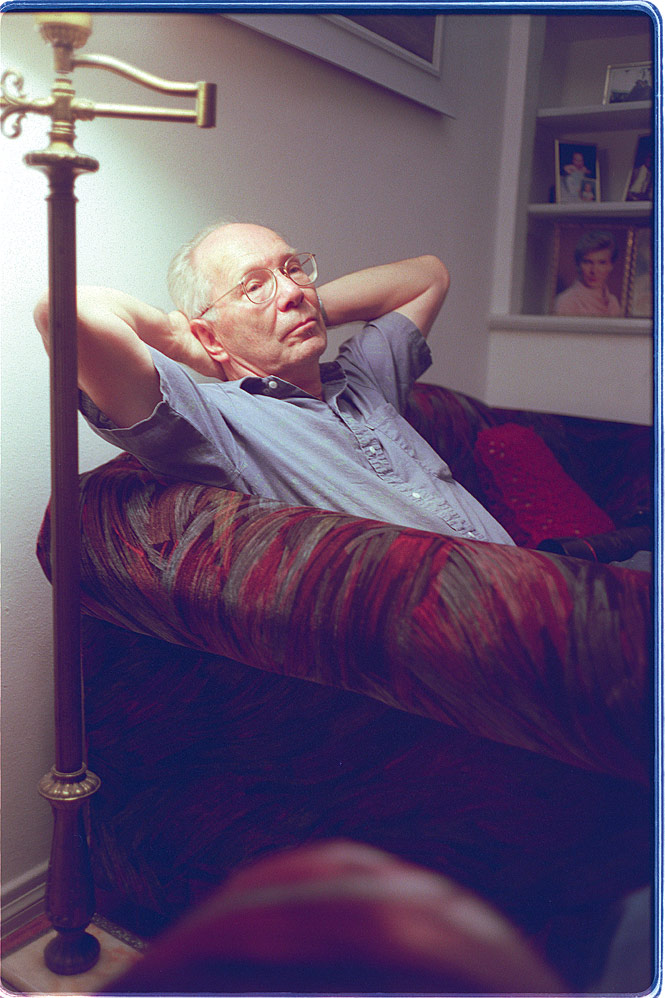
NAOMI: You mentioned, though, at that get-together in Germany, that was the best you ever saw those movies. I’ve never seen them that big.
ND: I never saw them that big before. That was the biggest I ever saw them, wonderful projector. I had to go out and buy, for five dollars, old falling down 8mm projectors, you can’t buy parts for it, and then I have to find parts for it to get it working just so I can show it on the screen so I can copy it with the camcorder, because you can’t buy those projectors anymore, you can’t even buy the film anymore. I have a beautiful camera here, and I can’t buy film for it.
AW: The letter that you wrote to us, that we published in the last issue, you’ve already had results from it?
ND: There’s one fellow who responded to it, he wants to design a new sail. He has some pretty good ideas, I thought. He called me up and said he had some problems to work out, and wanted to know if I could help him. The fact that part of it’s on my sail design he’s improving, he wanted to know what I can do. So we’ve been working together on it. I sent him sketches and ideas, and he’s going to send me some sketches back. But that came from the letter, yes.
AW: Wow, this has been illuminating! Thanks a lot . . .


